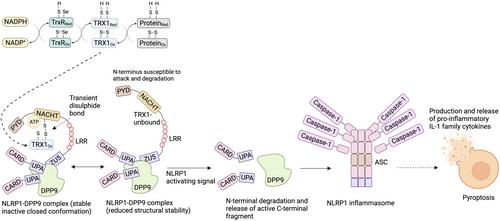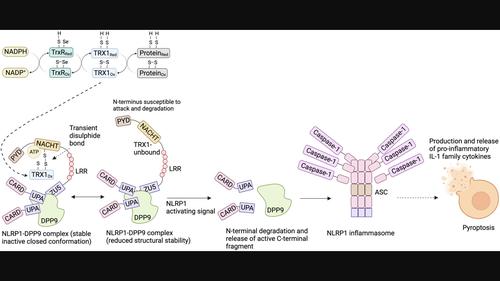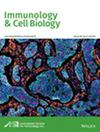氧化硫氧还蛋白1限制NLRP1炎症小体的活性。
IF 3.2
4区 医学
Q3 CELL BIOLOGY
引用次数: 0
摘要
自从大约20年前首次描述这种炎症小体以来,NACHT结构域和富含亮氨酸重复序列(NLR)以及含有pyrin结构域的1(NLRP1)炎症小体的生物学一直困扰着研究人员。氧化硫氧还蛋白1(TRX1)作为NLRP1抑制剂的鉴定最近将细胞氧化还原稳态与NLRP1炎症小体信号传导联系起来。现在,张等人。以前所未有的细节呈现了TRX1结合的NLRP1的分子结构。该结构为NLRP1激活的调控机制提供了关键见解,并为基于结构的抗炎药设计提供了巨大潜力。本文章由计算机程序翻译,如有差异,请以英文原文为准。


Oxidized thioredoxin 1 places a leash on NLRP1 inflammasome activity
The biology of the NACHT domain and leucine-rich repeat (NLR) and pyrin domain-containing 1 (NLRP1) inflammasome has perplexed researchers since this inflammasome was first described about two decades ago. The identification of oxidized thioredoxin 1 (TRX1) as a suppressor of NLRP1 recently linked cellular redox homeostasis to NLRP1 inflammasome signaling. Now, Zhang et al. present a molecular structure of TRX1-bound NLRP1 with unprecedented detail. This structure gives key insight into regulatory mechanisms governing NLRP1 activation and offers enormous potential for structure-based anti-inflammatory drug design.
求助全文
通过发布文献求助,成功后即可免费获取论文全文。
去求助
来源期刊

Immunology & Cell Biology
医学-免疫学
CiteScore
7.50
自引率
2.50%
发文量
98
审稿时长
4-8 weeks
期刊介绍:
The Australasian Society for Immunology Incorporated (ASI) was created by the amalgamation in 1991 of the Australian Society for Immunology, formed in 1970, and the New Zealand Society for Immunology, formed in 1975. The aim of the Society is to encourage and support the discipline of immunology in the Australasian region. It is a broadly based Society, embracing clinical and experimental, cellular and molecular immunology in humans and animals. The Society provides a network for the exchange of information and for collaboration within Australia, New Zealand and overseas. ASI members have been prominent in advancing biological and medical research worldwide. We seek to encourage the study of immunology in Australia and New Zealand and are active in introducing young scientists to the discipline.
 求助内容:
求助内容: 应助结果提醒方式:
应助结果提醒方式:


